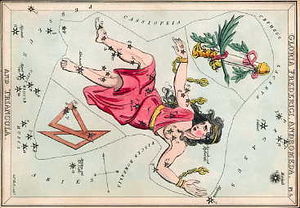Andromeda (constellation)
| Constellation | |
List of stars in Andromeda |
|
| Abbreviation | And |
|---|---|
| Genitive | Andromedae |
| Pronunciation | /ænˈdrɒmɨdə/, genitive /ænˈdrɒmɨdiː/ |
| Symbolism | Andromeda, the Woman Chained[1] |
| Right ascension | 1 h |
| Declination | +40° |
| Quadrant | NQ1 |
| Area | 722 sq. deg. (19th) |
| Main stars | 4, 18 |
| Bayer/Flamsteed stars |
65 |
| Stars with planets | 5 |
| Stars brighter than 3.00m | 3 |
| Stars within 10.00 pc (32.62 ly) | 3 |
| Brightest star | α And (Alpheratz) (2.07m) |
| Nearest star | Ross 248 (10.30 ly, 3.16 pc) |
| Messier objects | 3 |
| Meteor showers | Andromedids (Bielids) |
| Bordering constellations |
Perseus Cassiopeia Lacerta Pegasus Pisces Triangulum |
| Visible at latitudes between +90° and −40°. Best visible at 21:00 (9 p.m.) during the month of November. |
|
Andromeda is a constellation in the northern sky. It is named after Andromeda, the princess in the Greek legend of Perseus who was chained to a rock to be eaten by sea monster Cetus. It is sometimes called "the Chained Lady" or "the Chained Woman" in English (Mulier Catenata in Latin, al-Mar'at al Musalsalah in Arabic).[2] It has also been called Persea ("Perseus's wife")[2] or Cepheis ("Cepheus's daughter").[2] The Andromeda Galaxy is named after the constellation, as it appears within its boundaries.
Contents |
Notable features
Stars
- See also: List of stars in the constellation Andromeda
- α And (Alpheratz / Sirrah) is the brightest star in this constellation. It is a binary star with an overall apparent visual magnitude of 2.06m. This star forms an asterism known as the "Great Square of Pegasus" with three stars in Pegasus: α, β, and γ Peg. As such, the star was formerly considered to belong to both Andromeda and Pegasus, and was co-designated as "Delta Pegasi (δ Peg)", although this name is no longer formally used.
- β And (Mirach)is located in an asterism known as the "girdle". It is 200 light years distant and of magnitude 2.1m.
- γ And (Almach) is found at the tip of the southern leg of the big "A". It is a multiple star with contrasting colors.
- δ And (Sadiradra) is a 3rd magnitude star.
- ι And forms, with κ, λ, and ψ And, an asterism known as "Frederik's Glory",[3] a name derived from a former constellation Frederici Honores.
- υ And: has a planetary system with three confirmed planets, 0.71 times, 2.11 times, and 4.61 times the mass of Jupiter.
- ξ And (Adhil) is a binary star.
- n And (33 And) was a former designation for M31, the Andromeda Galaxy.
- 51 And was reassigned by Johann Bayer to neighbouring Perseus, where he designated it "Upsilon Persei (υ Per)", but it was returned to Andromeda by the International Astronomical Union.[4]
- 54 And: was a former designation for φ Per. [5]
Deep sky objects
The most famous deep sky object in Andromeda is a spiral galaxy Messier 31, the Andromeda Galaxy, one of the most distant objects visible to the naked eye (Messier 33, the Triangulum Galaxy, is slightly farther). It is an enormous spiral galaxy much like the Milky Way. To find the galaxy, draw a line between β and μ And, and extend the line approximately the same distance again from μ And.
Meteor showers
In November, the Andromedids meteor shower appears to radiate from Andromeda.
Illustrations

When the constellation is envisioned as representing the princess Andromeda, α Andromedae is normally considered to mark her head. However, the star's traditional Arabic names mean "horse" and "navel".[6]
Several other nearby constellations are associated with the myth of Andromeda, including Cassiopeia (her mother), Cepheus (her father), Cetus (the monster), Perseus (her saviour) and Pegasus (his horse).
Citations
References
- Allen R. H., (1899) Star-Names and Their Meanings, G. E. Stechert.
- Bakich, M. E., (1995) The Cambridge Guide to the Constellations, Cambridge University Press, Cambridge (UK).
- Ray H. A., (1997 The Stars — A New Way To See Them. Enlarged World-Wide Edition. Houghton Mifflin, Boston. ISBN 0-395-24830-2.*
- Ridpath. I., (1988) Star Tales, Lutterworth Press, Cambridge (UK).
- Ridpath, I., and Tirion W., (2007) Stars and Planets Guide, Collins, London. ISBN 978-0007251209. Princeton University Press, Princeton. ISBN 978-0691135564.
- Wagman, Morton (2003) Lost Stars, McDonald and Woodward, Blacksburg, Virginia. ISBN 0-939923-78-5.
External links
- The Deep Photographic Guide to the Constellations: Andromeda
- NightSkyInfo.com: Constellation Andromeda
- WIKISKY.ORG: Andromeda
- Star Tales – Andromeda
|
|||||
|
||||||||||||||||||||||||||||||||